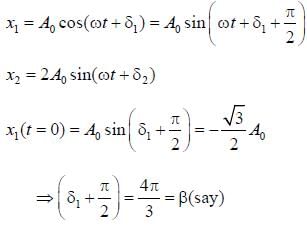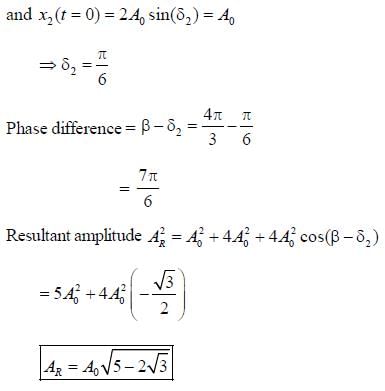IIT JAM Exam > IIT JAM Questions > Consider two simple harmonic motions represen...
Start Learning for Free
Consider two simple harmonic motions represented by  At
At  If these two simple harmonics are combined, what is the resultant amplitude:
If these two simple harmonics are combined, what is the resultant amplitude:
 At
At  If these two simple harmonics are combined, what is the resultant amplitude:
If these two simple harmonics are combined, what is the resultant amplitude:- a)A0√3
- b)A0
- c)

- d)

Correct answer is option 'C'. Can you explain this answer?
| FREE This question is part of | Download PDF Attempt this Test |
Verified Answer
Consider two simple harmonic motions represented byAtIf these two simp...


Most Upvoted Answer
Consider two simple harmonic motions represented byAtIf these two simp...



|
Explore Courses for IIT JAM exam
|

|
Consider two simple harmonic motions represented byAtIf these two simple harmonics are combined, what is the resultant amplitude:a)A0√3b)A0c)d)Correct answer is option 'C'. Can you explain this answer?
Question Description
Consider two simple harmonic motions represented byAtIf these two simple harmonics are combined, what is the resultant amplitude:a)A0√3b)A0c)d)Correct answer is option 'C'. Can you explain this answer? for IIT JAM 2024 is part of IIT JAM preparation. The Question and answers have been prepared according to the IIT JAM exam syllabus. Information about Consider two simple harmonic motions represented byAtIf these two simple harmonics are combined, what is the resultant amplitude:a)A0√3b)A0c)d)Correct answer is option 'C'. Can you explain this answer? covers all topics & solutions for IIT JAM 2024 Exam. Find important definitions, questions, meanings, examples, exercises and tests below for Consider two simple harmonic motions represented byAtIf these two simple harmonics are combined, what is the resultant amplitude:a)A0√3b)A0c)d)Correct answer is option 'C'. Can you explain this answer?.
Consider two simple harmonic motions represented byAtIf these two simple harmonics are combined, what is the resultant amplitude:a)A0√3b)A0c)d)Correct answer is option 'C'. Can you explain this answer? for IIT JAM 2024 is part of IIT JAM preparation. The Question and answers have been prepared according to the IIT JAM exam syllabus. Information about Consider two simple harmonic motions represented byAtIf these two simple harmonics are combined, what is the resultant amplitude:a)A0√3b)A0c)d)Correct answer is option 'C'. Can you explain this answer? covers all topics & solutions for IIT JAM 2024 Exam. Find important definitions, questions, meanings, examples, exercises and tests below for Consider two simple harmonic motions represented byAtIf these two simple harmonics are combined, what is the resultant amplitude:a)A0√3b)A0c)d)Correct answer is option 'C'. Can you explain this answer?.
Solutions for Consider two simple harmonic motions represented byAtIf these two simple harmonics are combined, what is the resultant amplitude:a)A0√3b)A0c)d)Correct answer is option 'C'. Can you explain this answer? in English & in Hindi are available as part of our courses for IIT JAM.
Download more important topics, notes, lectures and mock test series for IIT JAM Exam by signing up for free.
Here you can find the meaning of Consider two simple harmonic motions represented byAtIf these two simple harmonics are combined, what is the resultant amplitude:a)A0√3b)A0c)d)Correct answer is option 'C'. Can you explain this answer? defined & explained in the simplest way possible. Besides giving the explanation of
Consider two simple harmonic motions represented byAtIf these two simple harmonics are combined, what is the resultant amplitude:a)A0√3b)A0c)d)Correct answer is option 'C'. Can you explain this answer?, a detailed solution for Consider two simple harmonic motions represented byAtIf these two simple harmonics are combined, what is the resultant amplitude:a)A0√3b)A0c)d)Correct answer is option 'C'. Can you explain this answer? has been provided alongside types of Consider two simple harmonic motions represented byAtIf these two simple harmonics are combined, what is the resultant amplitude:a)A0√3b)A0c)d)Correct answer is option 'C'. Can you explain this answer? theory, EduRev gives you an
ample number of questions to practice Consider two simple harmonic motions represented byAtIf these two simple harmonics are combined, what is the resultant amplitude:a)A0√3b)A0c)d)Correct answer is option 'C'. Can you explain this answer? tests, examples and also practice IIT JAM tests.

|
Explore Courses for IIT JAM exam
|

|
Suggested Free Tests
Signup for Free!
Signup to see your scores go up within 7 days! Learn & Practice with 1000+ FREE Notes, Videos & Tests.
















